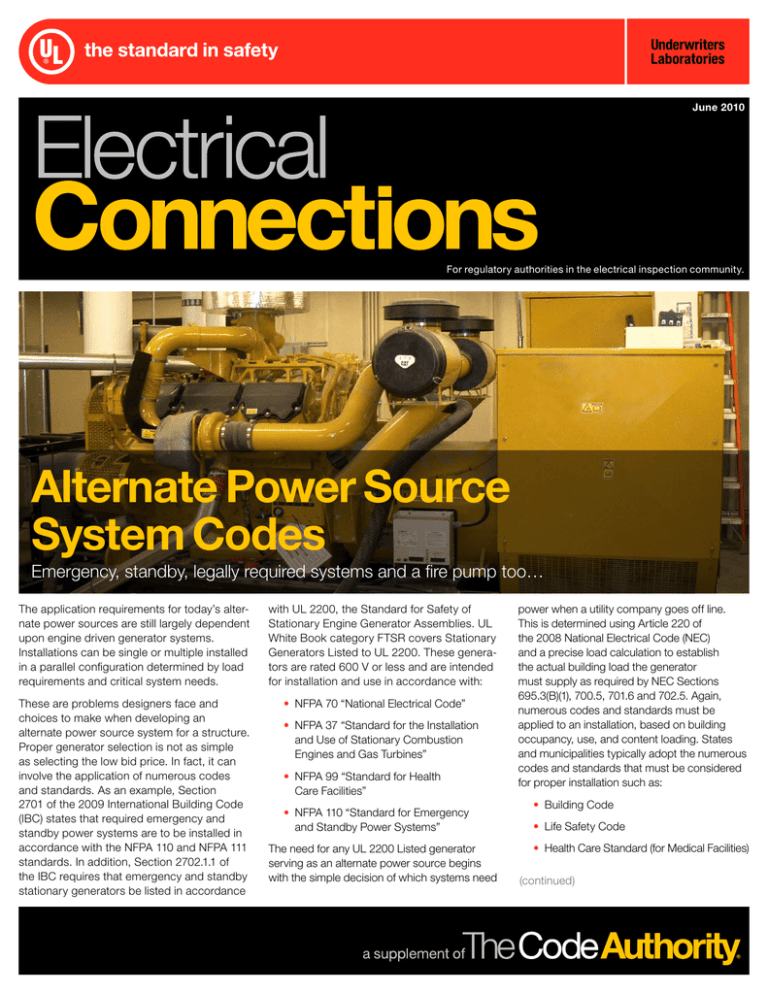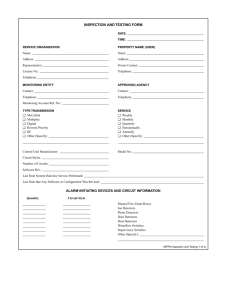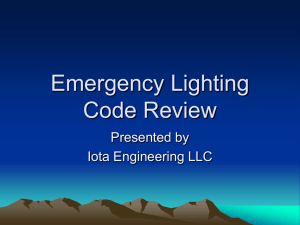Alternate Power Source System Codes
advertisement

June 2010 For regulatory authorities in the electrical inspection community. Alternate Power Source System Codes Emergency, standby, legally required systems and a fire pump too… The application requirements for today’s alternate power sources are still largely dependent upon engine driven generator systems. Installations can be single or multiple installed in a parallel configuration determined by load requirements and critical system needs. These are problems designers face and choices to make when developing an alternate power source system for a structure. Proper generator selection is not as simple as selecting the low bid price. In fact, it can involve the application of numerous codes and standards. As an example, Section 2701 of the 2009 International Building Code (IBC) states that required emergency and standby power systems are to be installed in accordance with the NFPA 110 and NFPA 111 standards. In addition, Section 2702.1.1 of the IBC requires that emergency and standby stationary generators be listed in accordance with UL 2200, the Standard for Safety of Stationary Engine Generator Assemblies. UL White Book category FTSR covers Stationary Generators Listed to UL 2200. These generators are rated 600 V or less and are intended for installation and use in accordance with: • NFPA 70 “National Electrical Code” • NFPA 37 “Standard for the Installation and Use of Stationary Combustion Engines and Gas Turbines” • NFPA 99 “Standard for Health Care Facilities” • NFPA 110 “Standard for Emergency and Standby Power Systems” The need for any UL 2200 Listed generator serving as an alternate power source begins with the simple decision of which systems need power when a utility company goes off line. This is determined using Article 220 of the 2008 National Electrical Code (NEC) and a precise load calculation to establish the actual building load the generator must supply as required by NEC Sections 695.3(B)(1), 700.5, 701.6 and 702.5. Again, numerous codes and standards must be applied to an installation, based on building occupancy, use, and content loading. States and municipalities typically adopt the numerous codes and standards that must be considered for proper installation such as: • Building Code • Life Safety Code • Health Care Standard (for Medical Facilities) (continued) UL Electrical Connections a supplement of The Code Authority® June 2010 Alternate Power Source System Codes (continued) • Fire Code • Sprinkler Code • Fire Pump Code • National Electrical Code What is unique about installing emergency and standby power systems is that often codes applicable to an installation, will reference and require the use of a second, third, or even a fourth code or standard. The combination of codes and standards determines the entire set of requirements for a proper installation of a specific generator system and its unique components and features. These codes and standards may have separate requirements, but they are all intended to work in harmony and impact the overall decision to make a code compliant installation. Here is a basic example: A building under design is required by Section 903 of the IBC to have a sprinkler protection system installed in accordance with NFPA 13, the Standard for Sprinkler Systems. The municipal water system supplying the building has inadequate pressure to make the sprinkler system design feasible. A fire pump is designed into the system as an acceptable water supply source to increase water pressure for the sprinklers. The designer specifies a fire pump that complies with NFPA 20, the Standard for Fire Pumps and required by NFPA 13 and Section 913 of the IBC. The fire pump now becomes part of the design requirement for the required sprinkler system. This UL 2200 Listed generator will supply three individual UL Listed transfer switches evaluated to UL 1008, Standard for Safety of Published by the Regulatory Services Department of Underwriters Laboratories Inc. © 2010. All rights reserved. Transfer Switch Equipment, to provide backup power to critical circuits. Additional information on transfer switches may be located in the UL White Book under categories: • WPTZ — Transfer Switches • WPWR — Automatic Transfer Switches for use in Emergency Systems • XNVE — Transfer Switches for use in Fire Pump Motor Circuits The fire pump disconnect must be a supervised connection as required by Section 695.4 of the NEC and clearly marked in at least one inch letters — as “Fire Pump Disconnecting Means,” with overcurrent protection that can carry locked rotor current indefinitely, and located some distance away to assure adequate physical separation from the other disconnects in accordance with NEC Sections 695.4(B)(1), (2), (3), (5), 695.6(C) and NFPA 20. From this supervised switch, feeder conductors are sized to 125 percent of the full load current of a fire pump motor, pressure maintenance pump plus 100 percent of any other associated equipment if supplied by this feeder per the requirements of NEC Section 695.6(C)(1). This application complies with both NEC Articles 695 and 700. The use of a vertical switchboard with separate sections is not permitted in a single generator installation due to the requirements of the NEC Sections 695.4(A) and (B)(2). Generator selection and sizing is only one of the many factors that designer’s face. NFPA 20 and NEC Section 695.7 include requirements that the voltage at controller line terminals shall not drop more than 15 percent below normal (controller-rated voltage) under motor-starting conditions, and the voltage at the motor terminals shall not drop more than 5 percent below the voltage rating of the motor when it is operating at 115 percent of the full-load current rating of the motor. This requires careful load calculation and generator sizing to accommodate all loads that must Managing Editor: Jeffrey A. Fecteau +1.651.408.8562 Jeffrey.Fecteau@us.ul.com www.ul.com/tcaec be served, and the fire pump started with no dip in voltage. If this proves problematic, load shedding on start up to eliminate voltage drop at the controller terminals becomes mandatory. Emergency and legally required standby generator systems must have a witness and load test prior to issuing a certificate of occupancy for a building as required by NEC Sections 700.4(A), (E) and 701.5(A), (E). The witness and load test are required to ensure that a generator listed to UL 2200 is properly sized and installed to carry all required loads. In addition to the previously mentioned requirements, NEC Section 695.10 requires fire pump equipment must be listed; additional information is located in the UL White Book under categories: • QXZF — Fire Pump Motors • QYZS — Fire Pump Controllers • QVUT — Pumping Equipment for Fire Service As the example illustrates, designers often face complex issues when designing power supply systems for fire pumps. Often what seems like a common sense approach may not be truly code compliant. Careful consideration of the above-mentioned codes and standards is essential to a code compliant design and to receive the approval of the code authorities from all the interested disciplines. For more information about UL Listed generators or UL Listed transfer switches, please contact Donnie Shields at +1.847.224.2760 or Donald.Shields@us.ul.com




